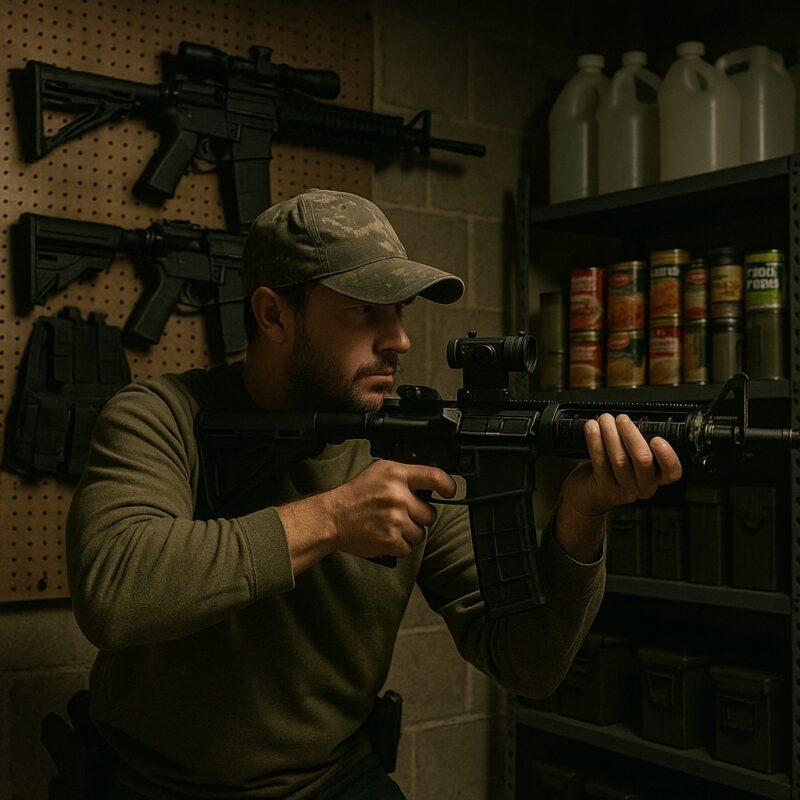Lessons, Prepper's Corner, Weapons
How to Harden Your Home: Tactical Defense Strategies That Actually Work
You might have the best bug-out plan in the world—but what if the threat hits while you’re still at home? Whether it’s civil unrest, natural disaster fallout, or a grid-down event, your home becomes your first line of defense. And if you think a deadbolt is enough, you’re already behind.
This isn’t about paranoia. It’s about strategy. If you call yourself prepared, your house better be, too. These home defense strategies are built from a tactical perspective—layered, realistic, and rooted in keeping what’s yours protected.
1. Think in Layers: Perimeter to Core
The key to home defense isn’t a single tool—it’s multiple overlapping systems that slow, expose, and stop intruders.
Outer Layer (Street to Fence):
- Motion-activated lighting (solar is ideal if the grid is down)
- Reinforced fencing or thorny landscaping (yes, that’s a thing)
- Camera surveillance with battery or solar backup
- Signage that says “monitored” or “armed” even if it’s not
Mid Layer (Yard to Doors):
- Smart placement of obstacles: thorny bushes under windows, gravel walkways (makes noise)
- No loose tools, ladders, or items that could aid entry
- Dogs. Big ones if you can. They don’t have to bite—just bark.
Core (Your House):
- Reinforced doors (metal or solid wood) with door armor kits
- Door jammers or bars on entry points
- Security film or bars on ground-level windows
- Blackout curtains or thermal barriers for grid-down visibility control
This alone can turn your home into a much harder target—and that’s the point. Most threats seek easy wins.
2. Entry Points: Reinforce What They’ll Target
The average residential door can be kicked in with one well-placed hit. Here’s how to stop that.
Doors:
- Replace short screws in strike plates and hinges with 3” wood screws
- Add a door reinforcement plate (like Door Armor or similar)
- Use a wedge or under-door jammer at night or during crisis periods
- Consider a second internal door lock that doesn’t rely on keys or electricity
Windows:
- Apply shatter-resistant film or install polycarbonate panes (hard to break and quiet)
- Lock all windows, even second-floor
- Add window alarms or vibration sensors
Most criminals will attempt forced entry within 30 seconds—make it take longer and louder.
3. Let There Be Tactical Light
Light is one of the most underrated defense tools you have. Why? Because bad actors thrive in the dark. The right lighting can deter break-ins before they start—or expose someone trying to sneak in unnoticed.
Exterior Lighting Tactics:
- Install motion-activated lights on every corner of your home—especially entry points and blind spots.
- Go solar-powered or connect to a backup battery so they work when the grid doesn’t.
- Use floodlights with wide coverage and mount them high to prevent tampering.
Interior Lighting Tactics:
- Use smart plugs or battery-operated lamps on timers during long outages or evacuations.
- Keep a tactical flashlight in every room—minimum 1,000 lumens with a strobe feature.
- Install small LED nightlights in hallways and stairwells. You don’t want to trip if the power’s out and things are loud.
You control the light—you control the space.
4. Create a Safe Room
Every serious prepper needs a fallback position inside the house—a space where your family can retreat, regroup, or wait out a threat.
Basic Safe Room Features:
- Reinforced door and frame with a secondary lock
- Hardwired or battery-powered communication tools (like a HAM radio, cell phone, or landline if it still works)
- First aid kit, water, flashlight, and a means of defense
- Low visibility from the outside—blacked out windows or covered vents
Bonus: store important documents and backups in this room inside a fireproof, waterproof safe.
This isn’t a “panic room.” It’s a stronghold.
5. Arm Yourself Intelligently
No defense plan is complete without addressing force. You don’t have to be a gun nut—but you do need a plan to respond if someone gets in.
Firearms for Home Defense:
- Shotgun: Ideal for close-quarters, simple operation, massive stopping power
- Handgun: Easier to maneuver in tight spaces, especially with a weapon light
- Rifle (AR/AK): If you’re trained and have the space, this is your apex predator
Other Tactical Tools:
- Pepper spray (with fog dispersion—not stream)
- Tactical batons or stun devices
- A high-lumen flashlight with a strike bezel
Training is mandatory. Don’t store anything you don’t know how to use under stress.
And remember: defense isn’t just about shooting. It’s about deterrence, delay, and surviving the encounter.
6. Build a Family Response Plan
Gear is useless if your people don’t know what to do. A threat can escalate in seconds. Everyone in the house—spouse, kids, roommates—needs to understand the plan.
What to Cover:
- Entry Protocols: Who answers the door? Who doesn’t? What’s the signal to fall back?
- Code Words: One word means “get to the safe room.” Another might mean “call 911.”
- Night Routine: Who locks doors, checks windows, sets alarms, and secures tools?
- Bug-In vs Bug-Out: Everyone needs to know when it’s safer to stay versus when it’s time to move.
Run drills. Make it second nature. Because when things get loud, confusion gets people hurt.
7. Off-Grid Comms and Surveillance
If cell towers are down or you’re in a blackout, your eyes and ears can’t rely on apps. Set up systems that work even in worst-case scenarios.
What You Need:
- Battery-operated radios to pick up local emergency broadcasts
- Walkie-talkies for room-to-room or yard communication
- HAM radio setup (if licensed) for long-range updates
- Old-school methods like mirrors, whistles, or flash signals if things go really bad
Also, back up your surveillance system with something that records locally—not just cloud-based. Power outages should never mean blind spots.
8. Final Tips That Most People Ignore
These details get overlooked—but they could be the edge between safe and sorry.
- Keep your landscaping trimmed—no bushes to hide behind, no tree limbs near upper windows
- Use gravel or rock near entryways—footsteps make noise
- Have a decoy safe with a little cash and junk jewelry
- Leave a pair of worn work boots on your porch—sends a message
- Know your neighbors—even if you’re not close, you want awareness of who belongs and who doesn’t
Preparedness is a mindset. And hardening your home isn’t about paranoia. It’s about stacking the odds in your favor—because when things fall apart, you fall to the level of your training and preparation.
We want to hear from you!
Are you confident your home is truly secure? Or did this list expose a few weak points? Drop your thoughts in the comments and let us know what you’re fixing first. Then check out our tactical gear lineup to turn your home into a fortress.


